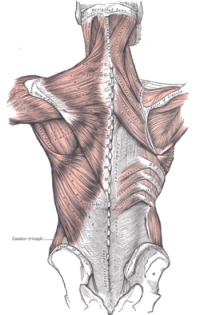Thoracolumbar Fascia: Difference between revisions
Wendy Walker (talk | contribs) No edit summary |
Wendy Walker (talk | contribs) No edit summary |
||
| Line 17: | Line 17: | ||
The illustration opposite shows the superficial muscles of the back. The thoracolumbar fascia is the gray area at bottom centre. | The illustration opposite shows the superficial muscles of the back. The thoracolumbar fascia is the gray area at bottom centre. | ||
The TLF is a girdling structure consisting of several aponeurotic and fascial layers that separates the paraspinal muscles from the muscles of the posterior abdominal wall. | |||
The superficial lamina of the posterior layer of the TLF (PLF) is dominated by the aponeuroses of the latissimus dorsi and the serratus posterior inferior. The deeper lamina of the PLF forms an encapsulating retinacular sheath around the paraspinal muscles. | |||
The middle layer of the TLF (MLF) appears to derive from an intermuscular septum that developmentally separates the epaxial from the hypaxialmusculature. | |||
<br> | <br> | ||
| Line 24: | Line 30: | ||
== Function == | == Function == | ||
The unyielding character of the deep fascia enables it to serve as a means of containing and separating groups of muscles into relatively well-defined spaces called ‘compartments’. The deep fascia integrates these compartments and transmits load between them. | The unyielding character of the deep fascia enables it to serve as a means of containing and separating groups of muscles into relatively well-defined spaces called ‘compartments’. The deep fascia integrates these compartments and transmits load between them. | ||
=== Motions Available === | === Motions Available === | ||
| Line 50: | Line 56: | ||
== Resources == | == Resources == | ||
== Recent Related Research (from [http://www.ncbi.nlm.nih.gov/pubmed/ Pubmed] | == Recent Related Research (from [http://www.ncbi.nlm.nih.gov/pubmed/ Pubmed)] == | ||
<div class="researchbox"> | <div class="researchbox"> | ||
<rss>Feed goes here!!|charset=UTF-8|short|max=10</rss> | <rss>Feed goes here!!|charset=UTF-8|short|max=10</rss> | ||
Revision as of 15:58, 9 August 2015
Original Editor - Wendy Walker
Lead Editors - Wendy Walker, Lucinda hampton, Kim Jackson, Sehriban Ozmen, WikiSysop, Naomi O'Reilly and Bruno Serra
Description[edit | edit source]
The thoracolumbar fascia is a large area of connective tissue - roughly diamond-shaped - which comprises the thoracic and lumbar parts of the deep fascia enclosing the intrinsic back muscles.
Most developed in the lumbar region, it consists of multiple layers of crosshatched collagen fibres that cover the back muscles in the lower thoracic and lumbar area before passing through these muscles to attach to the sacral bone.
Anatomy [edit | edit source]
The thoracolumbar fascia has 3 layers – posterior, middle and anterior.
These insert on the transverse and spinous processes of the lumbar vertebrae. They also attach to the iliac crest and fuse with the posterior surface of the sacrum.
The illustration opposite shows the superficial muscles of the back. The thoracolumbar fascia is the gray area at bottom centre.
The TLF is a girdling structure consisting of several aponeurotic and fascial layers that separates the paraspinal muscles from the muscles of the posterior abdominal wall.
The superficial lamina of the posterior layer of the TLF (PLF) is dominated by the aponeuroses of the latissimus dorsi and the serratus posterior inferior. The deeper lamina of the PLF forms an encapsulating retinacular sheath around the paraspinal muscles.
The middle layer of the TLF (MLF) appears to derive from an intermuscular septum that developmentally separates the epaxial from the hypaxialmusculature.
Function[edit | edit source]
The unyielding character of the deep fascia enables it to serve as a means of containing and separating groups of muscles into relatively well-defined spaces called ‘compartments’. The deep fascia integrates these compartments and transmits load between them.
Motions Available[edit | edit source]
Range of Motion[edit | edit source]
Closed Packed Position[edit | edit source]
Open Packed Position[edit | edit source]
Osteokinematics[edit | edit source]
Arthrokinematics[edit | edit source]
Pathology/Injury[edit | edit source]
Techniques[edit | edit source]
Palpation[edit | edit source]
Examination[edit | edit source]
Treatment[edit | edit source]
Resources[edit | edit source]
Recent Related Research (from Pubmed)[edit | edit source]
Extension:RSS -- Error: Not a valid URL: Feed goes here!!|charset=UTF-8|short|max=10
References[edit | edit source]
References will automatically be added here, see adding references tutorial.







